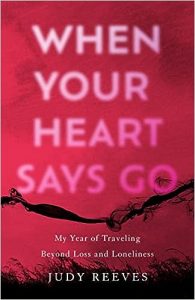The Long and Winding Road from Moments to Memoir by Judy Reeves
The Long and Winding Road from Moments to Memoir
Judy Reeves
Mid-point in draft four in my second novel, something interrupted my work and told me it was finally time to write a memoir. I say “something” because what do we call that urge that sends us in a direction we didn’t know we needed to go? What’s a name for that almost irresistible pull to leave one story and commit to writing another.
I knew at some point I would write the story of the trip I took after the death of my husband when I sold everything, bought an around-the-world airline ticket, packed a single suitcase, and set off on a year-long solo journey. Over the twenty-six years since I’d returned from that trip, I’d written many pieces that came out of the experience—short stories, poems, personal narrative essays. I’d written about people I met and places I’d been, as well as other journeys and other times, but I’d never dedicated myself to writing the story of that life-changing journey. I’d never written a memoir.
But there I was more than two decades after I’d returned home, sitting at my friend’s dining room table during a day-long mini-writing retreat, looseleaf notebook open to a blank page, pen in hand. Then I committed the first words to the page: “This is the memory.”
What followed were seven messy, hand-scrawled pages—about 1800 words that recalled a September afternoon in Salzburg, Austria when I visited a park to experience a what was billed as a “sensory circus.”
Thus began an almost daily morning writing practice during which I wrote one memory and then the next, composed not in an orderly, chronological structure, but nabbing memories as they showed up in some vague association that I could neither identify nor explain. I wrote, trusting what I’d read in Virginia Woolf’s A Writer’s Diary, “Arrange the pieces as they come.”
More than three decades of regular writing practice has taught me to trust the process. I knew if I interrupted the generous flow of memories to try to impose a structure or order, I would lose the spontaneity that was happening on those free-wheeling notebook pages. Certainly, I believed, some connection would be revealed at some point.
In her essay “Confluence,” in The Anatomy of Memory, Eudora Welty wrote, “The events in our lives happen in a sequence in time, but in their significance to ourselves they find their own order, a time-table not necessarily—perhaps not possibly—chronological.”
I teach a course called “From Moments to Memoir,” in which writers embark on expeditions to discover, uncover, and recover moments—both large and small—from their lives. I begin each session with the instructions, “Don’t try to think of something specific, just let a quick memory, a moment, come and capture it on the page by writing an instant of feeling or sensation.”
I give further instructions, “Be present in the moment you’re writing about. Small details hold the secrets of the moment. Sensory detail and description are the way not only to ground the writing in the physical world, but are also the avenue into the emotions.” And most importantly, “Slow down and open the moment to explore what might at first seem unimportant; if you notice it, it may hold something deeper that matters to your story.”
Memoir is made up of such moments, one revealed and then another, as the memoirist seeks answers. In memoir, we’re not just writing “this is what happened.” We’re writing, “This is what happened, and this is how it affected who I am today.” In the course, writers explore those moments, looking for connections and links that, when woven into a memoir, tell a story both personal and universal.
The instructions I give my students are the same I laid out for myself. This is how that moment of 600 words I originally wrote in my journal at a café in Salzburg that September day in 1990, became a scene of 1800 words written at my friend’s dining room table in June 2016.
Many such moments I experienced over the time of my journey were opened and explored as I wrote and remembered, remembered and wrote. To be sure many of those moments led to flashbacks of experiences I’d had as a young girl, to the years with my husband, his illness and death, and to reflections of how these memories connected one to another and ultimately revealed the story of how I became who I am today.
In her essay, Welty continues, “The time as we know it subjectively is often the chronology that stories and novels follow: it is a continuous thread of revelation.”
Over the next two years, those regular writing sessions of moments remembered and relived, resulted in ten looseleaf, spiral-bound notebooks that contained the first draft of my memoir. Two more years of revising and editing followed, working with writing groups to get feedback on drafts, submitting the manuscript to a developmental editor then a line editor. Finally, in 2021, I completed the final draft of my memoir, When Your Heart Says Go – My Year of Traveling Beyond Loss and Loneliness.
The long and winding road—moments to memoir—led to a destination I never expected and couldn’t predict. Not just going from writing memories to completing and publishing a book, but from writing memories to discover a deeper understanding of myself and telling the story of who I am.
—
When Your Heart Says Go – My Year of Traveling Beyond Loss and Loneliness

When Your Heart Says Go, Judy Reeves
What sort of mad longing besets a woman―nearing fifty and recently widowed―to sell everything she owns, buy an around-the-world airline ticket, pack a single suitcase, and set off alone on a year-long journey without a plan or agenda? When Your Heart Says Go answers that question.
Set in 1990–’91, Judy’s story takes readers from San Diego through eleven European countries, the then-Soviet Union, and finally India, during the lead-up to the first Gulf War.
Explorations of foreign locales and interactions with strangers and acquaintances who become a lifeline to friendship are interspersed with occasional flashbacks to Judy’s life with her beloved husband, Tom, as well as his illness and death. Descriptions of sites historic and current serve as both daily life and background for Judy’s struggle to find her way as a sober, single, independent woman in the vast world as it edges toward the collapse of the Soviet Union and war in the Middle East. The outer journey serves as a container for the inner; the more Judy experiences of the world, the more she learns about herself―and the closer she gets to realizing her lifelong dream of being a writer.
BUY HERE
 Judy Reeves is an award-winning writer and teacher whose books include A Writer’s Book of Days (named “Best Nonfiction” by the San Diego Book Awards and a “Hottest Books for Writers” by Writer’s Digest), Writing Alone/Writing Together, The Writer’s Retreat Kit, and Wild Women, Wild Voices.
Judy Reeves is an award-winning writer and teacher whose books include A Writer’s Book of Days (named “Best Nonfiction” by the San Diego Book Awards and a “Hottest Books for Writers” by Writer’s Digest), Writing Alone/Writing Together, The Writer’s Retreat Kit, and Wild Women, Wild Voices.Category: Contemporary Women Writers, On Writing


























I love how this happened, and can’t wait to read it.